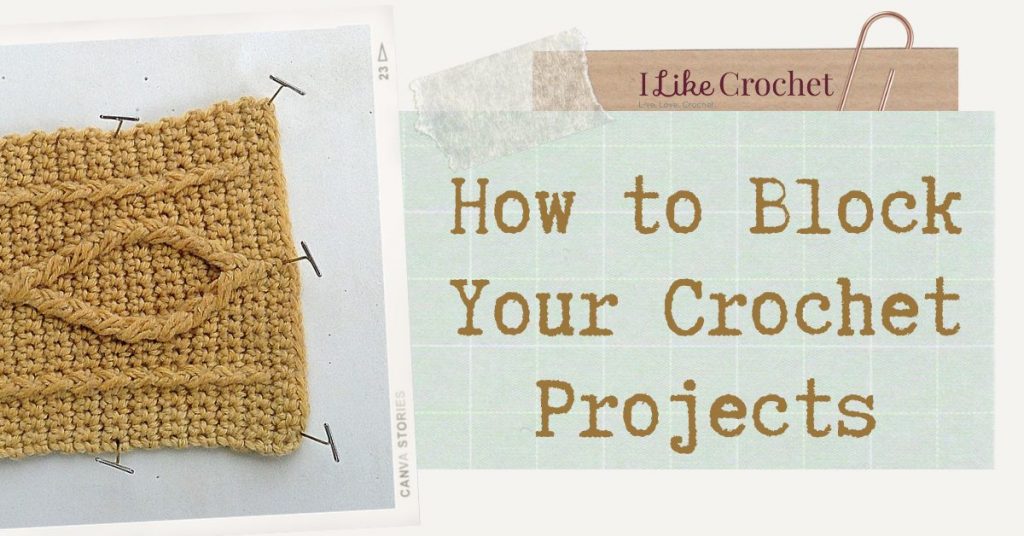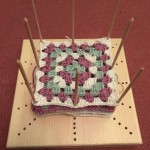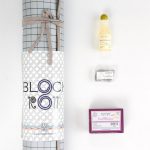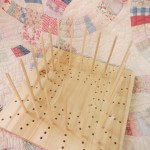
Why should you block crochet? Blocking your crochet items puts a nice finishing touch on all your hard work, and it gives the final product a professional appearance. You’ll set your stitches into place, be able to correct minor errors like slightly uneven tension, and restore symmetry to items. If you made a wearable piece, you can also make minor sizing adjustments with a proper blocking process.
Wondering how to block crochet? There are three main methods of blocking: wet, dry, and cold. Which method you choose will depend on the yarn content, what the item is and, honestly, your preference. For instance, I rarely do a full “wet” block process because it just isn’t my favorite. Before you choose, make sure to always consult your yarn label, because you don’t want to ruin something you just spent hours making. You might even want to use that gauge swatch you made before starting your project to test that the method you choose is the best for your yarn.
So, what do you need when learning how to block?
You don’t need much to properly block an item: water, pins and space are the very basics. The type of pins you use when you block crochet are important: they must be rust-proof. Regular pins can quickly leave rust stains on your work, and that certainly doesn’t look too professional. If space is a premium for you, you can block on a mattress or a clean section of carpeted floor. One additional item that I cannot be without when blocking is a large wooden spoon. I use the spoon to gently “whack” my piece to set the stitches. You can use your hand, but when working with something large, like an afghan, your hand will quickly tire. Finally, if you would like to hurry the drying process along, you can aim a fan at your work.
Dry Blocking
Dry blocking is perfect for fibers that can tolerate heat and moisture, and it’s best for wearable items. Once you have finished your piece, pin it out to the desired shape and size. Be sure to use plenty of pins to keep distortion at a minimum. Smooth the item as much as possible before holding a steamer or iron set to steam slightly above the fabric. Do not press the item, but slowly move your iron over the surface. Use your wooden spoon to “whack” where there are stubborn lumps and bumps. Allow to completely cool and dry before removing pins.
Cold Blocking
Cold blocking is for those delicate fibers that can tolerate a minimum of moisture but no heat at all. As with dry blocking, pin the item out and smooth it as best as you can. Gently mist with a spray bottle of clean water. To keep your item looking its best, try to use distilled water. Once evenly misted, gently pat out any stubborn areas. Again, allow the item to dry completely before removing pins.
Wet Blocking
Wet blocking is perfect for natural fibers that can tolerate being gently washed. Gently soak your piece in a bathtub and carefully squeeze out the water, but be sure not to twist or wring your work. I will often squeeze it gently, then lay it out on a towel. Be careful here, the extra weight of the water can really stretch your work, so try to support the piece as much as possible. Once on the towel, I will roll the towel carefully and pat the roll to further squeeze out any extra water. Next, lay the piece out where you plan to block it and gently pat into the desired shape and size. Use your pins to hold the item securely in place. After the piece is pinned, gently “whack” it with your hand or spoon. This firmly sets the stitches and will smooth any lumps and bumps. Leave the piece until completely dry.
Now you know how to block crochet! Blocking may not be your favorite part of the process, but it is relatively easy and makes a world of difference to your finished project. The results will speak for themselves! Give it a try, you won’t regret it. Be sure to check out these blocking essentials to get started:
Crochet Blocking Board | Blocking Essentials Kit | Wooden Blocking Board







How would I block a large very fine Alpaca Shawl ?
Hi June! I believe this article will help:
https://www.ilikecrochet.com/daily/crochet-techniques/finishing-techniques/how-to-wet-block-crochet-projects/
– Nicola, Editor
I made a big blanket with acrylic yarn.
I think that it need some blocking – but how?
It’s too big!
Can you help me, please?
Best wishes
Marianne
I have a shortcut method to blocking with moisture! I wet and heat towels in the microwave and lay them out on the item to be blocked that I have shaped on a mattress. You can use the same towel and just reheat it in the microwave to finish blocking the whole thing, if it’s too big for one towel, or use more towels. I dries so much faster than wetting the whole blanket or item and easier that using an iron. It works!!
I am crocheting a baby blanket with acrylic yarn. Do I need to block it?
While blocking is not strictly necessary for acrylic yarn, it can still be beneficial in certain situations. However, keep in mind that acrylic yarn does not behave the same way as natural fibers like wool or cotton when wet. It doesn’t absorb water in the same manner, so the blocking process may be less effective and might not hold as long. Remember to always check the care instructions on the yarn label, as some acrylic yarns may have specific recommendations from the manufacturer. If you’re unsure, you can also make a small swatch with the same yarn and test blocking it to see how it reacts.
Should an item be Re locked every time it gets washed?
Not necessarily. The need for re-blocking after washing largely depends on the type of yarn used, the stitch pattern, and how the item is constructed. Ultimately, the decision to re-block after washing is up to you. It’s a good idea to observe how your item behaves after washing and use your judgment. If it looks and feels fine without re-blocking, there may not be a need to go through the process again. – Nicola, Editor
What happens if you don’t block something? I crocheted a hand/dish towel for a friend and gave it to them before I could block it. It is made with 100% cotton. Should I recommend that she hand wash the item & lay flat before washing/drying in the machine?
Hi Amanda! That’s a good recommendation, and I would say that for a cotton dishcloth, blocking might not be as important just because of the nature of the item being used regularly with water and soap. If it was a sweater, blocking is a bit more of an important necessity. Hope that helps! – Nicola, Editor